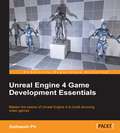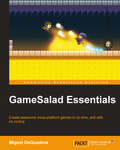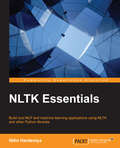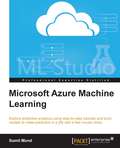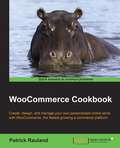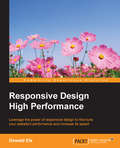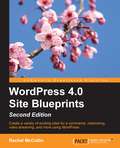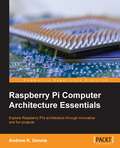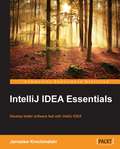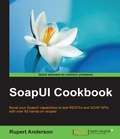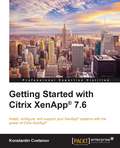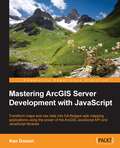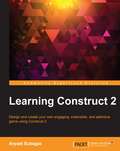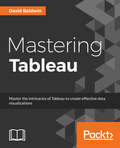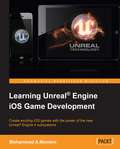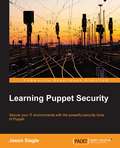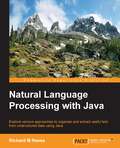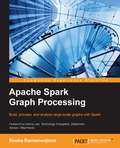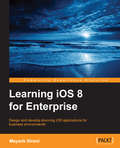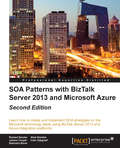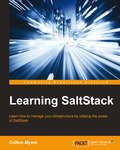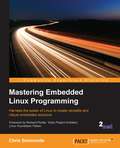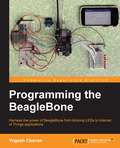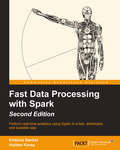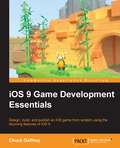- Table View
- List View
Unreal Engine 4 Game Development Essentials
by Satheesh PvMaster the basics of Unreal Engine 4 to build stunning video games About This Book * Get to grips with the user interface of Unreal Engine 4 and find out more about its various robust features * Create dream video games with the help of the different tools Unreal Engine 4 offers * Create video-games and fully utilize the power of Unreal Engine 4 to bring games to life through this step-by-step guide Who This Book Is For If you have a basic understanding of working on a 3D environment and you are interested in video game development, then this book is for you. A solid knowledge of C++ will come in handy. What You Will Learn * Download both the binary and source version of Unreal Engine 4 and get familiar with the UI * Get to know more about the Material Editor and how it works * Add a post process to the scene and alter it to get a unique look for your scene * Acquaint yourself with the unique and exclusive feature of Unreal Engine 4--Blueprints * Find out more about Static and Dynamic lighting and the difference between various lights * Use Matinee to create cut scenes * Create a health bar for the player with the use of Unreal Motion Graphics (UMG) * Get familiar with Cascade Particle Editor In Detail Unreal Engine 4 is a complete suite of game development tools that gives you power to develop your game and seamlessly deploy it to iOS and Android devices. It can be used for the development of simple 2D games or even stunning high-end visuals. Unreal Engine features a high degree of portability and is a tool used by many game developers today. This book will introduce you to the very popular Unreal 4 engine with hands-on instructions to build stunning video games. You will begin by creating a new project or prototype by learning the essentials of Unreal engine, then you'll get an understanding of how the World Browser can help to improve performance of our game. Next, we'll create a level of detailed models and materials to further improve performance. After that, you'll see how to import textures, create different materials, and see what materials can do in terms of post-processing. Finally, you will get acquainted with the Paper2D tool and the blueprints system to further increase our project's performance with Engine's scalability tools. Style and approach This step-by-step guide will help you gain practical knowledge about Unreal Engine through detailed descriptions of all the tools offered by Unreal Engine.
GameSalad Essentials
by Miguel DequadrosIf you want to create your own game, but don't know where to start, this is the book for you. Whether you've used GameSalad before, or have prior game development experience or not you are sure to learn! Imaging software experience, such as Photoshop, is good to have, but art and assets are provided in the book's resources.
NLTK Essentials
by Nitin HardeniyaIf you are an NLP or machine learning enthusiast with some or no experience in text processing, then this book is for you. This book is also ideal for expert Python programmers who want to learn NLTK quickly.
Microsoft Azure Machine Learning
by Sumit MundThe book is intended for those who want to learn how to use Azure Machine Learning. Perhaps you already know a bit about Machine Learning, but have never used ML Studio in Azure; or perhaps you are an absolute newbie. In either case, this book will get you up-and-running quickly.
WooCommerce Cookbook
by Patrick RaulandIf you have ever built or managed a WordPress site and want to add e-commerce functionality into your site, WooCommerce and this book are perfect for you. Learning how to use WooCommerce through this series of recipes will give you a solid platform to add any future e-commerce needs.
Responsive Design High Performance
by Dewald ElsThis book is ideal for developers who have experience in developing websites or possess minor knowledge of how responsive websites work. No experience of high-level website development or performance tweaking is required.
WordPress 4.0 Site Blueprints - Second Edition
by Rachel MccollinCreate a variety of exciting sites for e-commerce, networking, video streaming, and more, using WordPress About This Book * Build ten different types of website using WordPress * Transfer your static site to WordPress and create sites to make money, build communities, and share your ideas * The projects in the book will teach you how to use free themes and plugins without any prior coding experience Who This Book Is For WordPress Site Blueprints is suitable for new or experienced WordPress users. You don't need to be a PHP developer or have ever created a WordPress theme or plugin. Instead the book will help you use themes and plugins (all free) to create a wide range of sites. Familiarity with the WordPress interface will help you but you don't need to be able to write code. What You Will Learn * Migrate your old static site into WordPress * Create a network of sites for other people to work with each other * Build a great store using the free WooCommerce plugin * Create a video streaming site linked to YouTube * Create a review site for products, services, or anything you'd like * Create a jobs board so people can post jobs and apply for them * Create websites that focus on networking such as a social media site, a communications center for your team, and a membership site to build a community * Create a beautiful gallery site to showcase your photography In Detail WordPress is the world's most popular Content Management System (CMS) and you can use it to create any kind of site you or your clients need. Using free plugins and themes for WordPress, you can create a store, a social media site, a review site, a video site, a network of sites or a community site, and more. Wordpress makes your job of creating your own website simple and hassle-free! If you've started using WordPress to create a blog or simple website, you'll have had a taste of the opportunities offered by this massively popular CMS. This book will take you through the process of creating ten popular kinds of site using WordPress with free plugins and themes, each chapter covering various functionality of the web. After having learned how to migrate from your static site to Wordpress in the first chapter, you will then explore the world of social networking websites followed focusing on e-commerce. Without writing too much code, you'll be able to create a store, a video streaming site, a team communications site, a jobs board, and more. This book is a one-stop solution to resolve all your worries about creating a website that will give the best experience to your users. Style and approach A project-based step-by-step guide to creating ten different types of popular website using WordPress. This book takes you through clear and logical steps, with screenshots and tips along the way to help you follow the guide and learn how to get more from WordPress.
Raspberry Pi Computer Architecture Essentials
by Andrew K. DennisExplore Raspberry Pi's architecture through innovative and fun projects About This Book * Explore Raspberry Pi 2's hardware through the Assembly, C/C++, and Python programming languages * Experiment with connecting electronics up to your Raspberry Pi 2 and interacting with them through software * Learn about the Raspberry Pi 2 architecture and Raspbian operating system through innovative projects Who This Book Is For Raspberry Pi Computer Architecture Essentials is for those who are new and those who are familiar with the Raspberry Pi. Each topic builds upon earlier ones to provide you with a guide to Raspberry Pi's architecture. From the novice to the expert, there is something for everyone. A basic knowledge of programming and Linux would be helpful but is not required. What You Will Learn * Set up your Raspberry Pi 2 and learn about its hardware * Write basic programs in Assembly Language to learn about the ARM architecture * Use C and C++ to interact with electronic components * Find out about the Python language and how to use it to build web applications * Interact with third-party microcontrollers * Experiment with graphics and audio programming * Expand Raspberry Pi 2's storage mechanism by using external devices * Discover Raspberry Pi 2's GPIO pins and how to interact with them In Detail With the release of the Raspberry Pi 2, a new series of the popular compact computer is available for you to build cheap, exciting projects and learn about programming. In this book, we explore Raspberry Pi 2's hardware through a number of projects in a variety of programming languages. We will start by exploring the various hardware components in detail, which will provide a base for the programming projects and guide you through setting up the tools for Assembler, C/C++, and Python. We will then learn how to write multi-threaded applications and Raspberry Pi 2's multi-core processor. Moving on, you'll get hands on by expanding the storage options of the Raspberry Pi beyond the SD card and interacting with the graphics hardware. Furthermore, you will be introduced to the basics of sound programming while expanding upon your knowledge of Python to build a web server. Finally, you will learn to interact with the third-party microcontrollers. From writing your first Assembly Language application to programming graphics, this title guides you through the essentials. Style and approach This book takes a step-by-step approach to exploring Raspberry Pi's architecture through projects that build upon each other. Each project provides you with new information on how to interact with an aspect of the Raspberry Pi and Raspbian operating system, providing a well-rounded guide.
IntelliJ IDEA Essentials
by Jaroslaw KrochmalskiThis book is for developers who want to work smarter so they can focus their efforts on the details that will give them the advantage. This book is tailor-made for developers who want to move from NetBeans and Eclipse to experience the power and functionality of IntelliJ IDEA.
SoapUI Cookbook
by Rupert AndersonThis book is aimed at developers and technical testers who are looking for a quick way to take their SoapUI skills and understanding to the next level. Even if you are new to SoapUI but have basic Java skills and a reasonable grasp of RESTFul and Soap web services, then you should have no problem making use of this book.
Getting Started with Citrix XenApp® 7.6
by Konstantin CvetanovInstall, configure, and support your XenApp systems with the power of Citrix XenAppAbout This BookFamiliarize yourself with Citrix applications and desktop virtualizationMaintain and troubleshoot your XenApp environment to minimize system downtime. <P><P>A hands-on, step-by-step guide with a practical approach and real-world examples to get you up and running with XenApp systemsWho This Book Is ForThis book is intended for IT administrators and consultants who want to build application and desktop virtualization solutions for their employers and customers. No prior knowledge of Citrix technologies is required.What You Will LearnMake the use case for Citrix XenApp and design your first systemPrepare your existing IT infrastructure for XenApp and learn what licenses you needInstall and configure the XenApp infrastructureEnable access with StoreFront and NetScaler GatewayEnable load balancing with NetScalerMaintain servers and publish applications and desktopsManage printing in a Citrix environmentTroubleshoot your environment using advanced tools and methodologies employed by Citrix Escalation TeamsIn DetailIf you want to effectively deploy the various components of Citrix XenApp to create an enterprise environment for application and desktop delivery, this hands-on guide is perfect for you. You start off by understanding the need and benefits of Citrix XenApp with respect to Virtualization technology. After this, you will get to grips with the requirement analysis and designing aspect of building XenApp systems and all the necessary installation and configuration procedures for Citrix XenApp, StoreFront and NetScalar Gateway are explained one by one in detail.Step-by-step, you will learn to deploy your first XenApp with the Machine Creation Services method and Provisioning Services method. After this, you will explore the administering part of applications and systems, followed by printing in the XenApp environment. Next, you will learn all the trips and tricks required to troubleshoot and support the XenApp environment. By the end of this book, you will be ready to go live with your new XenApp environment.Style and approachThis is a step-by-step guide to technical implementations in a conversational and easy-to-follow style. Each component is deployed sequentially until a full solution is built. Basic as well as advanced features of the product are explored to appeal to the widest possible audience interested in the topic.
Mastering ArcGIS Server Development with JavaScript
by Ken DomanTransform maps and raw data into full-fledged web mapping applications using the power of the ArcGIS JavaScript API and JavaScript libraries About This Book * Create and share modern map applications for desktops, tablets, and mobile browsers * Present and edit geographic and related data through maps, charts, graphs, and more * Learn the tools, tips, and tricks made available through the API and related libraries with examples of real-world applications Who This Book Is For This book is intended for intermediate developers who want to design web mapping applications. You should have some experience with geographic information systems, especially with ArcGIS products such as ArcGIS Server. It also helps to have some experience with HTML, CSS, and JavaScript. What You Will Learn * Create single-page mapping applications, lining up data from different sources * Search for and display geographic and tabular information based on locations and attributes * Customize maps and widgets to deliver the best user experience * Present location data intuitively using charts and graphs * Integrate mapping applications with your favorite JavaScript frameworks * Test the working of your web map application and take advantage of cloud services such as ArcGIS Online * Create modern-looking web maps through styling tips and tricks In Detail ESRI and its ArcGIS line of software have been an industry leader in digital map production and publication for over 30 years. ArcGIS Server lets you design, configure, and publish maps that can be viewed and edited through the Internet. After designing basic maps, you may want to find out new and innovative ways to represent information using these maps. In this book, you'll work through practical examples, experiencing the pitfalls and successes of creating desktop and mobile map applications for a web browser using the ArcGIS Server platform. The book begins by introducing you to ArcGIS Server and ESRI's JavaScript API. You'll work with your first web map and then move on to learn about ESRI's building blocks. A Dojo AMS style widget will help you create your own widgets for a map and then see how to collect geographic data. Furthermore, you will learn different techniques such as using Dojo Charts to create charts and graphs to represent your data. Then you will see how to use ESRI JavaScript API with other JavaScript libraries and different styling methods to make your map stand out. By the end of the book, you will discover how to make your application compatible with different devices and platforms and test it using testing libraries. Style and approach An in-depth guide that explores web application development using ArcGIS Server and the ArcGIS JavaScript API. Topics are explained in the context of developing two applications for fictional clients. Details of application development, including possible pitfalls and best practices, are included in this book.
Learning Construct 2
by Aryadi SubagioIf you want to make your own game but don't know how to start or don't have the technical skills to do it, then this is the book for you. You don't need to have a programming background to understand the concepts explained.
Mastering Tableau
by David BaldwinMaster the intricacies of Tableau to create effective data visualizations About This Book * Arm yourself with an arsenal of advanced chart types and geocoding to efficiently and engagingly present information * Map a grid over a network node diagram and use that grid to demonstrate loads, processing time, and more in Tableau * Integrate R with Tableau by utilizing R functions, libraries, and saved models Who This Book Is For If you are a business analyst without developer-level programming skills, then this book is for you. You are expected to have at least a fundamental understanding of Tableau and basic knowledge of joins, however SQL knowledge is not assumed. You should have basic computer skills, including at least moderate Excel proficiency. What You Will Learn * Create a worksheet that can display the current balance for any given period in time * Recreate a star schema from in a data warehouse in Tableau * Combine level of detail calculations with table calculations, sets, and parameters * Create custom polygons to build filled maps for area codes in the USA * Visualize data using a set of analytical and advanced charting techniques * Know when to use Tableau instead of PowerPoint * Build a dashboard and export it to PowerPoint In Detail Tableau has emerged as one of the most popular Business Intelligence solutions in recent times, thanks to its powerful and interactive data visualization capabilities. This book will empower you to become a master in Tableau by exploiting the many new features introduced in Tableau 10.0. You will embark on this exciting journey by getting to know the valuable methods of utilizing advanced calculations to solve complex problems. These techniques include creative use of different types of calculations such as row-level, aggregate-level, and more. You will discover how almost any data visualization challenge can be met in Tableau by getting a proper understanding of the tool's inner workings and creatively exploring possibilities. You'll be armed with an arsenal of advanced chart types and techniques to enable you to efficiently and engagingly present information to a variety of audiences through the use of clear, efficient, and engaging dashboards. Explanations and examples of efficient and inefficient visualization techniques, well-designed and poorly designed dashboards, and compromise options when Tableau consumers will not embrace data visualization will build on your understanding of Tableau and how to use it efficiently. By the end of the book, you will be equipped with all the information you need to create effective dashboards and data visualization solutions using Tableau. Style and approach This book takes a direct approach, to systematically evolve to more involved functionalities such as advanced calculation, parameters & sets, data blending and R integration. This book will help you gain skill in building visualizations previously beyond your capacity.
Learning Unreal® Engine iOS Game Development
by Muhammad A. MoniemIf you are a game developer, designer, artist, or a beginner in the gaming industry, and want to make iOS games efficiently at a low cost, this book is ideal for you.
Learning Puppet Security
by Jason SlagleIf you are a security professional whose workload is increasing, or a Puppet professional looking to increase your knowledge of security, or even an experienced systems administrator, then this book is for you. This book will take you to the next level of security automation using Puppet. The book requires no prior knowledge of Puppet to get started.
Natural Language Processing with Java
by Richard M ReeseIf you are a Java programmer who wants to learn about the fundamental tasks underlying natural language processing, this book is for you. You will be able to identify and use NLP tasks for many common problems, and integrate them in your applications to solve more difficult problems. Readers should be familiar/experienced with Java software development.
Apache Spark Graph Processing
by Rindra RamamonjisonThis book is for data scientists and big data developers who want to learn the processing and analyzing graph datasets at scale. Basic programming experience with Scala is assumed. Basic knowledge of Spark is assumed.
Learning iOS 8 for Enterprise
by Mayank BiraniIf you are an experienced iPhone application developer or even a newbie, this book will help you to build on and explore your technical skills. This book is very helpful for those who want to learn about the new framework of iOS 7 and iOS 8.
SOA Patterns with BizTalk Server 2013 and Microsoft Azure - Second Edition
by Richard Seroter Mark BrimbleIf you are a developer who has been tasked with building service-oriented BizTalk Server solutions, this book is for you. It will help you to envision an enterprise solution and implement the software blueprint.
Learning SaltStack
by Colton MyersIf you are a system administrator who manages multiple servers, then you know how difficult it is to keep your infrastructure in line. If you've been searching for an easier way, this book is for you. No prior experience with SaltStack is required.
Mastering Embedded Linux Programming
by Chris SimmondsHarness the power of Linux to create versatile and robust embedded solutions About This Book * Create efficient and secure embedded devices using Linux * Minimize project costs by using open source tools and programs * Explore each component technology in depth, using sample implementations as a guide Who This Book Is For This book is ideal for Linux developers and system programmers who are already familiar with embedded systems and who want to know how to create best-in-class devices. A basic understanding of C programming and experience with systems programming is needed. What You Will Learn * Understand the role of the Linux kernel and select an appropriate role for your application * Use Buildroot and Yocto to create embedded Linux systems quickly and efficiently * Create customized bootloaders using U-Boot * Employ perf and ftrace to identify performance bottlenecks * Understand device trees and make changes to accommodate new hardware on your device * Write applications that interact with Linux device drivers * Design and write multi-threaded applications using POSIX threads * Measure real-time latencies and tune the Linux kernel to minimize them In Detail Mastering Embedded Linux Programming takes you through the product cycle and gives you an in-depth description of the components and options that are available at each stage. You will begin by learning about toolchains, bootloaders, the Linux kernel, and how to configure a root filesystem to create a basic working device. You will then learn how to use the two most commonly used build systems, Buildroot and Yocto, to speed up and simplify the development process. Building on this solid base, the next section considers how to make best use of raw NAND/NOR flash memory and managed flash eMMC chips, including mechanisms for increasing the lifetime of the devices and to perform reliable in-field updates. Next, you need to consider what techniques are best suited to writing applications for your device. We will then see how functions are split between processes and the usage of POSIX threads, which have a big impact on the responsiveness and performance of the final device The closing sections look at the techniques available to developers for profiling and tracing applications and kernel code using perf and ftrace. Style and approach This book is an easy-to-follow and pragmatic guide consisting of an in-depth analysis of the implementation of embedded devices. Each topic has a logical approach to it; this coupled with hints and best practices helps you understand embedded Linux better.
Programming the BeagleBone
by Yogesh ChavanMaster BeagleBone programming by doing simple electronics and Internet of Things projects About This Book * Quickly develop electronics projects that interact with Internet applications using JavaScript and Python * Learn about electronics components such as sensors and motors, and how to communicate with them by writing programs * A step-by-step guide to explore the exciting world of BeagleBone--from connecting BeagleBone to doing electronics projects and creating IoT applications Who This Book Is For If you want to learn programming on embedded systems with BeagleBone by doing simple electronics projects, this book is for you. This book is also helpful to BeagleBone owners who want to quickly implement small-scale home automation solutions. It is assumed that you have familiarity with C and Python programming. Some familiarity with electronics is helpful but not essential. What You Will Learn * Connect your BeagleBone to a computer in different ways and get the Cloud9 IDE running to quick-start programming on the BeagleBone * Get to know about BeagleBone extension pins such as GPIO and how to connect various electronics components with BeagleBone * Read and write to various electronics components such as LED, Push-button, sensors, and motors * Grasp in-depth theory on Analog, PWM, and BUS programming and the electronics components used in programs * Handle data to and from various BUS supporting modules such as UART, I2C, and SPI using the Adafruit BBIO Python library * Write real-life IoT applications in JavaScript and Python such as shooting an e-mail on overheat and controlling a servo motor remotely * Make use of online free cloud services to store and analyze sensor data collected on the BeagleBone * Discover what else can be done using the BeagleBone * Get to grips with embedded system BUS communication In Detail The whole world is moving from desktop computers to smartphones and embedded systems. We are moving towards utilizing Internet of Things (IoT). An exponential rise in the demand for embedded systems and programming in the last few years is driving programmers to use embedded development boards such as Beaglebone. BeagleBone is an ultra-small, cost-effective computer that comes with a powerful hardware. It runs a full-fledged Debian Linux OS and provides numerous electronics solutions. BeagleBone is open source and comes with an Ethernet port, which allows you to deploy IoT projects without any additions to the board. It provides plenty of GPIO, Anlaog pins, and UART, I2C, SPI pins which makes it the right choice to perform electronics projects. This gives you all the benefits of Linux kernel such as multitasking, multiusers, and extensive device driver support. This allows you to do programming in many languages including high-level languages such as JavaScript and Python. This book aims to exploit the hardware and software capabilities of BeagleBone to create real-life electronics and IoT applications quickly. It is divided into two parts. The first part covers JavaScript programs. The second part provides electronics projects and IoT applications in Python. First, you will learn to use BeagleBone as tool to write useful applications on embedded systems. Starting with the basics needed to set up BeagleBone and the Cloud9 IDE, this book covers interfacing with various electronics components via simple programs. The electronics theory related to these components is then explained in depth before you use them in a program. Finally, the book helps you create some real-life IoT applications. Style and approach An easy-to-follow guide full of real-world electronics programs and quick troubleshooting tips using BeagleBone. All the required electronics concepts are explained in detail before using them in a program and all programs are explained in depth. Most of the theory is covered in the first part; while the second part gives you some quick programs.
Fast Data Processing with Spark - Second Edition
by Holden Karau Krishna SankarFast Data Processing with Spark - Second Edition is for software developers who want to learn how to write distributed programs with Spark. It will help developers who have had problems that were too big to be dealt with on a single computer. No previous experience with distributed programming is necessary. This book assumes knowledge of either Java, Scala, or Python.
iOS 9 Game Development Essentials
by Chuck GaffneyDesign, build, and publish an iOS game from scratch using the stunning features of iOS 9About This BookCreate storyboards in Xcode from concept to code and designChalk out your game's overall navigation and structureWork with 2D and 3D game development toolsWho This Book Is ForThis book is intended for game developers who wish to develop 2D and 3D games for iPhone and iPad. If you are a developer from another platform, or game engine such as Android or Unity, a current iOS developer wishing to learn more about Swift and the latest features of iOS 9, or even if you are new to game development, then this book is for you. Some prior programming knowledge is recommended, but not required.What You Will LearnFamiliarise yourself with both basic and advanced Swift game development codeUnderstand the structure and flow of a typical iOS appWork with the SpriteKit framework to make 2D games, sprites, and overlaysDiscover 3D game development with SceneKitVisually design levels and game assets with XCode 7's latest featuresExplore the concept of component-based structuring with iOS 9's GameplaykitBeta test and publish your game with iTunes ConnectIn DetailGame development has always been a combination of programming and art, and mobile game development is no exception to this rule. The iOS platform has been both a staple in the ever-growing mobile game market, as well as a launching point for many game developers (hobby and career-wise). The features and frameworks available in iOS 9 continue to cater to the synergy of design and computer engineering, using tools that allow developers to take a game idea from concept to application in record time.Whether you are new to iOS and game development as a whole, or are an experienced programmer wanting to learn the latest features of the platform, iOS 9 Game Development Essentials will provide you with crucial insight into this widely used platform.Starting with the Swift programming language, this book gets the ball rolling with code concepts and game-centric code samples right from the get-go, giving you get a solid understanding of Apple's cutting-edge programming language. The book takes you through iOS game development concepts and introduces the various frameworks that allow you to develop robust, reusable, and intelligent game components in both 2D and 3D game environments.Style and approachThis book is a step-by-step guide into the code and concepts of iOS apps. Each chapter contains diagrams that showcase the features of the platform, along with code samples from Apple and code samples exclusive to this book.
